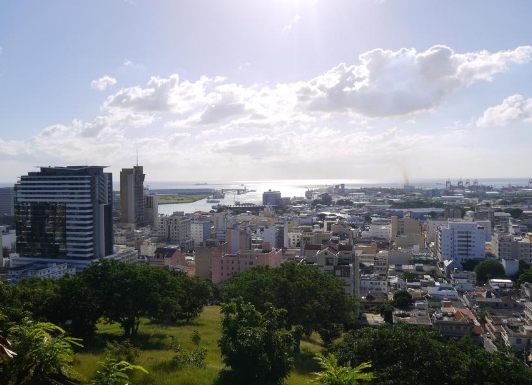Mauritius, or "Sweet Island," sets sights on Chinese market for sugar export

Photo taken on May 8, 2017 shows people play Kite Surfing near Le Morne Brabant in the southwest part of Mauritius. Mauritius is an island nation in the Indian Ocean about 2,000 kilometres off the southeast coast of the African continent. (Xinhua/Wu Changwei)
In recent years, cooperation between China and Mauritius is on the rise thanks to the Free Trade Agreement (FTA) between the two countries. In fact, Sweet Island is eyeing the Chinese market to revitalize its sugar industry.
"Mauritius was made first, and then heaven; and heaven was copied after Mauritius." These words by American writer Mark Twain have made Mauritius famous for its paradise-like scenery. However, little is known about its other nickname: Sweet Island.
The name "Sweet Island" comes from the island's most important crop, sugar cane. At time of its independence in the 1960s, 90 percent of Mauritius's arable land was devoted to sugar cane cultivation, and the sugar industry once generated nearly one-third of the country's gross domestic product (GDP) and more than 90 percent of its total exports.
In recent years, cooperation between China and Mauritius is on the rise thanks to the Free Trade Agreement (FTA) between the two countries. In fact, Sweet Island is eyeing the Chinese market to revitalize its sugar industry.
The sugar industry plays an important role in the local economy and social development of Mauritius. "Maintaining the sustainability of the sugar cane industry is crucial for Mauritius," said Chief Executive Officer of the Mauritius Sugar Syndicate (MSS) Devesh Dukhira.
Dukhira said that sugar still accounts for some 15 percent of the country's total exports while, together with the by-products bagasse and molasses, the industry contributes more than 2 percent of its gross domestic product (GDP), not to mention its positive impact on the environment, including avoidance of soil erosion, and hence preservation of its lagoons.
However, since the turn of the century, the Mauritian sugar industry has encountered serious challenges, especially with the abolition of guaranteed prices in 2009 under the defunct European Union (EU) Sugar Protocol in the European market, once the main destination for Mauritian sugar. As it subsequently became exposed to world market price volatility and distortion, sugar revenue unfortunately became unpredictable, which has resulted in an increased rate of land abandonment.
"Mauritius is a small and isolated island, so the freight takes much time and money to go to Europe, even to Asia. And with a rise in the freight price, it's getting even more difficult for the containers to be shipped to the world market," said Gunness Bhuruth, whose family has been engaged in sugar cane cultivation for generations.
"There were farmers who preferred to leave their land fallow rather than continue to grow sugar cane," he said.
In January 2021, a Free Trade Agreement between China and Mauritius came into force. As the first of its kind between China and an African country, the trade agreement has proven to be a game-changer, as it set up a specific tariff-rate quota for Mauritian sugar, making the export volume to China increase to over 13,000 tons in that year.
"As a small island, the quantity of our sugar production is limited. So we have to be able to differentiate ourselves from global suppliers. We have to focus on the quality of our sugar," Bhuruth said.
Dukhira stressed that the marketing strategy is to "complement rather than replace" the sugar being produced in China. "The marketing of the Mauritius sugar has been assigned to COFCO (China Oil and FoodStuffs Corporation) which, despite being a sugar producer itself, focuses on the special attributes of these high value-added wholesome special sugar to secure a long-standing position in niche market segments within China, such as in high-end retail supermarkets, in the catering trade and among specific industrial users such as bakeries," he said. "The main differentiating factor would be the additive-free characteristics."
Mauritian special sugars are widely known for the natural intensity of their aroma and tastes, and are rich in antioxidants and minerals, according to the website of the Mauritius Sugar Syndicate, a non-profit organization established in 1919 that focuses on promoting the sales of Mauritian sugar before distributing the net proceeds to the local producers.
In October 2023, a special booth was allotted by COFCO to Mauritian special sugars at the China Food and Drinks Fair in Shenzhen, China. "We are on the right track," said Dukhira. "We rely a lot on this FTA and the support of COFCO to meet our sales target in China, which should in the near future become one of the most important export destinations for Mauritius sugar."
Gregory Bathfield, CEO of Alteo Milling, the largest sugar factory in Mauritius, expressed hope for a bright future. "We are hopeful that all the benefits can be materialized in the next few years. It would be a great achievement and bring more remuneration to all the stakeholders," Bathfield said.
Editor:伏娅敏
